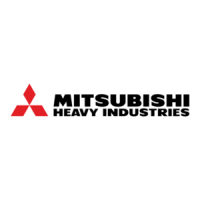
Do you have a question about the Mitsubishi Heavy Industries SRK35MA-S and is the answer not in the manual?
| Cooling Capacity | 3.5 kW |
|---|---|
| Heating Capacity | 4.0 kW |
| Energy Efficiency Ratio (EER) | 3.21 |
| Power Supply | 230V / 1ph / 50Hz |
| Indoor Unit Dimensions (W x H x D) | 800 x 290 x 215 mm |
| Outdoor Unit Dimensions (W x H x D) | 800 x 600 x 300 mm |
| Weight (Indoor Unit) | 9.5 kg |
| Refrigerant | R410A |
| Type | Split System |
| Energy Efficiency Ratio (Cooling) | 3.21 W/W |
| Noise Level (Outdoor Unit) | 50 dB |
Details key operational features and technological aspects of the air conditioner.
Explains the system for identifying different models based on their codes and specifications.
Describes the operational capabilities and functions of the air conditioning models.
Specifies the environmental conditions within which the air conditioners are designed to operate safely.
Provides detailed dimensional drawings and visual layouts of the indoor and outdoor units.
Illustrates the operational flow and components of the cooling and heating cycle.
Presents graphical data for correcting cooling and heating capacities based on operating conditions.
Displays the electrical circuit schematic for specific indoor and outdoor unit models.
Displays the electrical circuit schematic for the 50MA-S model.
Identifies and labels the various components of the indoor and outdoor units.
Explains how to use the emergency ON/OFF button for basic operation when the remote is unavailable.
Describes the function that restores the unit's previous operating state after a power interruption.
Details the self-cleaning function that runs the fan to dry moisture and inhibit mold growth.
Describes the mode that automatically regulates temperature for comfortable sleep and energy saving.
Explains how to set the timer to automatically switch off the air conditioner after a specified period.
Explains how to set the timer to automatically switch on the air conditioner at a desired time.
Explains the mode that provides rapid cooling or heating for 15 minutes using maximum fan speed.
Details the function that reduces energy consumption by regulating compressor frequency and reducing current.
Explains how to adjust the vertical and horizontal flaps for optimal air distribution within the room.
Details how the system automatically selects the optimal operating mode based on temperature and humidity.
Explains the conditions and process for the automatic defrosting cycle during heating operation.
Explains the control mechanisms for the compressor's ON/OFF states and speed adjustments.
Details the control strategies and speed settings for the outdoor fan under various operating conditions.
Explains the control logic and speed settings for the indoor fan across different modes and conditions.
Outlines essential safety warnings and precautions to be followed during the installation process.
Provides guidelines for choosing optimal locations for indoor and outdoor units to ensure proper function.
Details the procedures for mounting the indoor unit, including plate fixing and panel removal/installation.
Outlines the steps for securely installing the outdoor unit and connecting electrical components.
Describes the process of connecting refrigerant pipes, including preparation and flare nut procedures.
Lists standard operating data, including pressure, temperature differences, and current consumption for various models.
Provides a systematic approach to diagnose electrical component failures and common error indications.
Explains essential servicing procedures like evacuation and refrigerant charging for maintaining the system.
Details diagnostic procedures and circuit diagrams for troubleshooting outdoor unit components.
Explains how to inspect the outdoor unit's circuit board and inverter for proper functioning.
Details the procedure for checking the electronic expansion valve (EEV) and its coil.
Provides steps to check the outdoor fan motor and its circuit board for malfunctions.
Introduces R410A refrigerant, its environmental impact, and chemical properties compared to R22.
Provides information on the chemical properties, composition, and pressure characteristics of R410A refrigerant.
Details the materials, procedures, and precautions for mounting refrigerant pipes using copper and specific joints.
Specifies the types of copper pipes, joints, and their suitability for R410A refrigerant.
Offers guidance on the proper handling and storage of piping materials to prevent contamination and damage.
Explains the procedures and precautions for welding refrigerant pipes, including oxidation prevention.
Covers essential tasks related to R410A system installation, removal, and servicing procedures.
Lists specialized tools required for installation and servicing of R410A systems, including applicability.
Details the steps for new installation, including vacuum pump usage and refrigerant charging.
Outlines procedures for removing the equipment, including refrigerant recovery and unit disconnection.
Stresses the importance of using new refrigerant piping when replacing equipment with R410A.
Warns against using R410A with equipment designed for conventional refrigerants to avoid malfunction.
Provides steps for correctly recharging refrigerant into the system during servicing.
Explains the general procedures and precautions for recovering refrigerant from the system.
Details the steps involved in the refrigerant recovery process, including checks and connections.
Lists necessary accessories and tools required for R410A refrigerant recovery operations.
